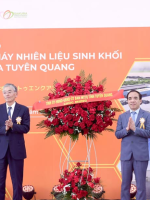
Vietnam plans to have renewables account for 15-20% of total primary energy by 2030 and the weight will be raised to 65-70% by 2045, according to the newly approved National Energy Development Strategy.
The nation’s total primary energy output is expected to hit 150-170 million tons of oil equivalent (TOE) by 2030 and 260-280 million TOEs by 2045.
Total final energy consumption is set to reach 105-115 million TOEs and 160-180 million TOEs by 2030 and 2045, respectively.
The country plans to build a smart and efficient power system capable of safely connecting to the regional power grid, ensuring safe and stable power supply.
By 2030, Vietnam will be among the top 4 countries in ASEAN in electricity supply reliability and a top 3 in the region’s access-to-electricity index.
Under the new strategy, oil refining facilities will meet at least 70% of the country’s petroleum demand. Vietnam will strive to expand petroleum reserves to 75-80 days of net import after 2030 and have enough capacity to import 15-20 billion cubic meters of liquefied natural gas (LNG) in 2030 and 10-15 billion cubic meters in 2045.
The ratio of saved energy to total final energy consumption compared to the normal development scenario is set to reach about 7-10% in 2030 and about 14-20% in 2045.
Compared to the normal development scenario, Vietnam will reduce greenhouse gas emissions from energy activities by 15-35% by 2030 and 70-80% by 2045.
The new strategy, taking effect February 1, 2024 under the Prime Minister’s Decision 215/QD-TTg, sets the overall goals of firmly ensuring national energy security, considering it a foundation and an important premise for the country’s socio-economic development,
It prioritizes rapid and sustainable energy development, ecological environment protection and climate change adaptation, towards meeting the nation’s net zero emissions target by 2050.
According to the decision, Vietnam will develop four energy sub-sectors including oil and gas, coal, electricity and new, renewable energy.
To develop Vietnam’s energy industry (until 2030, with vision until 2045) the government has set out specific tasks and solutions to restructure the sector and encourage investments; train and develop human resources; protect the environment and respond to climate change; and promote international cooperation.
It has assigned the Ministry of Industry and Trade to coordinate with relevant ministries, agencies and localities to study and propose mechanisms and policies to implement the National Energy Development Strategy.
The ministry will closely monitor the balance of energy supply and demand and the implementation of key energy programs and projects; and propose mechanisms and policies to encourage development of renewable energy projects.
It will also work to complete legal conditions and technical infrastructure for the development of competitive electricity, gas and coal markets.
Thanh Thuy, Minh Hue




